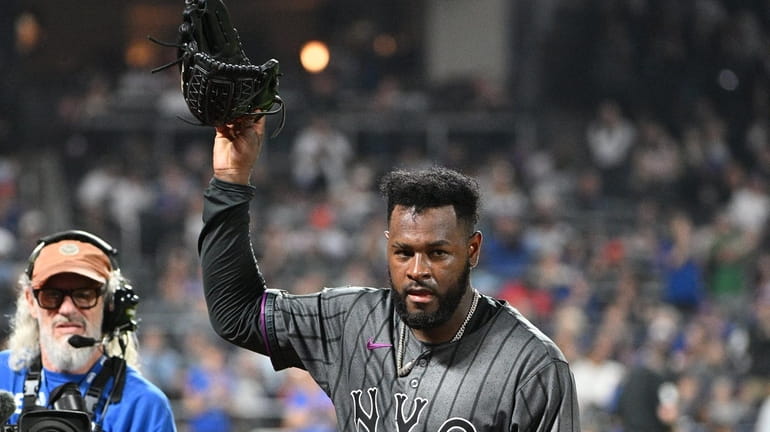Mets' staff pitching effectively through first month of season

Mets starting pitcher Luis Severino raises his glove as he heads to the dugout after the top of the eighth inning against the Chicago Cubs in an MLB baseball game at Citi Field on Monday, April 29, 2024. Credit: Kathleen Malone-Van Dyke
On paper, through the season’s first month, the Mets’ rotation doesn’t present a dazzling statistical resume.
After Sean Manaea’s one-run, 92-pitch, five-inning rockfight Tuesday in the Mets’ 4-2 victory over the Cubs, the starters’ 3.95 ERA ranked 17th in the majors, their 1.38 WHIP a few ticks below, tied for 21st. As a group, the rotation was averaging only 5.2 innings, which had them in MLB’s bottom third as well.
Those numbers deserve an asterisk, however. Remove the disappointing Adrian Houser, and the ERA dramatically shrinks to 3.08, good enough to place third overall -- tied with the Royals -- trailing only the Red Sox (2.07) and Phillies (2.50).
In other words, the Mets’ rotation, non-Houser division, can be a surprisingly effective crew, further reinforced by the back-to-back gems thrown by Jose Quintana and Luis Severino this week. The one sticking point in analyzing the Mets’ starting staff had been that concerning lack of length, but Quintana and Severino each went eight innings after no one had even touched the seventh in the team’s first 26 games.
On top of that, Quintana and Severino were only the third Mets’ tandem to go eight or more innings in consecutive starts since 2015. Kodai Senga and Carlos Carrasco accomplished the feat only last year; Noah Syndergaard and Bartolo Colon before them during the World Series season.
Good thing, too, because with Manaea battling command issues Tuesday and his pitch count skyrocketing early, manager Carlos Mendoza had the luxury of a well-rested bullpen -- even with Edwin Diaz unavailable. On this night, five innings was enough, as four relievers chipped in to finish the job, including Jorge Lopez’s second save this season.
“At the end of the day I want to eat up innings and go deep into ballgames,” said Manaea, who allowed just three singles but also gave up four walks. “But games like that it’s just a grind to get through five. We did that, and it’s a positive direction.”
Based on the outcome, sure. Despite Manaea’s struggles with control, the Mets are still 4-2 in his starts, showing that they don’t need nightly superhuman efforts from the rotation. The current competitive level should be adequate, with enough of an innings-uptick to protect a bullpen in danger of red-lining too early. After Tuesday’s victory, the Mets’ relief corps had a 2.85 ERA -- best in the NL and sixth overall -- and their 141 strikeouts were tops in the majors. But that success is almost impossible to sustain without the rotation shouldering more of the innings load. Quintana and Severino combining for 16 innings over two days was what made Manaea’s shorter cameo stand up.
“Over the course of the year, we will need to get a little bit more out of our starters,” said president of baseball operations David Stearns. “This isn’t terribly unusual in April. But our guys for the most part have been able to get us into that fourth or fifth inning, so you haven’t had too many of those super-short starts that can really tax your pen.
“Sure, we’d like to see our starters get a little bit deeper. I think, while our bullpen has picked up a pretty substantial load, no individual pitcher has picked up a load that I would consider to be concerning.
Here’s the good news for the Mets: Aside from Houser -- acquired by Stearns via trade from the Brewers, his former club -- the rest of the rotation is pitching at or close to their expected ceilings. Particularly Severino, who carried a no-hit bid into the eighth inning Monday and lowered his ERA to 2.31 ERA, which ranked fourth in the NL among qualified starters.
“I think before, when I was a little younger, I was thinking too much about striking everybody out,” Severino said. “Right now, I just focus on getting people out and getting deep in the game. So I’m in a different position now. Maybe it’s more important to throw innings than striking everybody out.”
The Mets are plenty OK with that. The same goes for Quintana, who has a 3.48 ERA with only a 16.0% K rate. Manaea (3.07 ERA) and Jose Butto (2.86) were at the top of the rotation’s K class, with rates of 25.2% and 27.8%, respectively. Stearns understandably stuck up for his guy Houser in discussing the staff’s weak link, but the Mets do have potential upgrades on the horizon.
Tylor Megill (shoulder strain) is the closest on the rehab timeline and could rejoin the rotation during the Mets’ next homestand (May 10). David Peterson (hip surgery) shouldn’t be far behind, and Kodai Senga (shoulder strain) -- the staff’s presumed ace -- said Monday that he anticipates coming off the IL not long after May 27, the first date he’s eligible. On the prospect front, spring-training standout Christian Scott already is loudly knocking on the door at Triple-A Syracuse, where the 24-year-old righthander is 3-0 with a 3.20 ERA, 0.71 WHIP and 12.8 strikeouts/nine innings.
Stearns doesn’t sound like he wants to play the Scott card quite yet. Despite the hysteria over Senga going down in February, Stearns’ patchwork rotation has held it together through April -- and should only get stronger in the weeks ahead, whether Houser gets fixed or has to be replaced.
